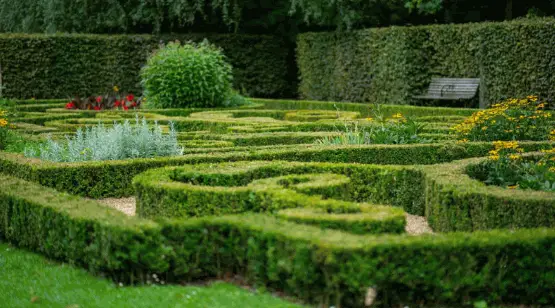Hedge topping is a popular technique used in landscaping to trim and shape hedges. The practice involves cutting the top of the hedge to create a flat or rounded surface, which can help maintain its neat appearance.
Hedge topping is particularly useful for formal hedges that require precise shaping, although you can use it on informal hedges to keep them under control.
Definition Of Hedge Topping
Hedge topping, also known as hedge shearing, refers to cutting back the top portion of a hedge to create a flat or uniform surface. It is typically done for aesthetic reasons, to maintain a neat appearance of the hedge. However, it can also help promote healthy growth by stimulating new growth at the base of the plant, as it allows the maximum sunlight to flood through, which can also benefit other plants and leading shoots. This process involves cutting the hedge at a specific height to create a flat or rounded surface.
This process involves hedge-trimming tools such as shears or a powered hedge trimmer. Electric hedge trimmers are powerful, but when used appropriately, they allow significant control when you trim hedges, creating your desired shape such as a v shape. This provides you with more control to shape overgrown branches and flowering shrubs in a manner that is aesthetically pleasing.
Hedge topping is different from hedge trimming, as when you trim hedges, this incorporates cutting the sides of the hedge to maintain its shape.
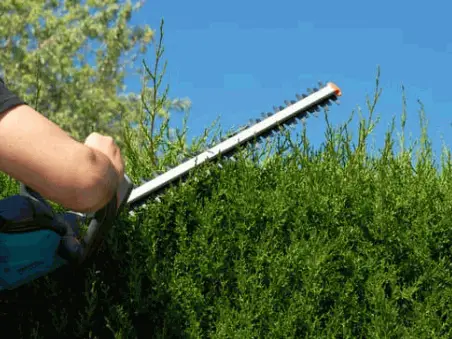
Importance Of Hedge Topping
Hedge topping plays a vital role in maintaining the health and aesthetics of hedges. When done correctly, it promotes healthy growth by allowing sunlight and air circulation throughout the plant.
Additionally, it helps prevent pests and diseases from taking hold by removing dead or diseased branches. A well-maintained hedge also adds value and curb appeal to a property.
When To Top Hedges?
The timing for hedge topping depends on the specific type of plant being trimmed. For most hedges, waiting until after their spring flush of growth is recommended before cutting back the top portion.
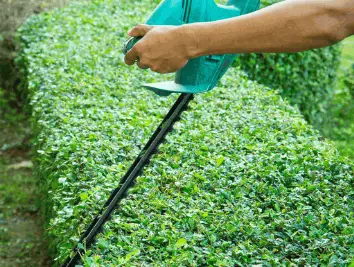
Wait Until Growing Season Is Well Underway Or Passed
This usually occurs in late spring or early summer and ensures that new growth has had enough time to establish itself before being cut back. Avoid topping hedges in late summer or early fall, as this can interfere with winter hardiness and increase susceptibility to winter injury. Late winter is definitely the wrong time to cut a hedge or even the top of the hedge in the UK!
Tools Required For Hedge Topping – Even On Tall Hedges
It would help if you had the appropriate tools to achieve a neat and uniform finish when trimming hedges. The essential tools required are gloves, pruning shears or loppers for removing thick branches/ stems and hedgers, or a powered trimmer/saw for shaping large areas quickly and efficiently. To learn more about the best hedge trimmer brands, take a look at our post.
A sturdy ladder is necessary if you have taller hedges over six feet high. Also, if you have overgrown hedges, formative pruning is often easier at a height, and with the right equipment such as a reliable hedge trimmer or dependable electric trimmers. Even for lower branches, leverage often helps to get the power and control you need.
Understanding what hedge topping involves helps prepare gardeners for effective maintenance practices while considering the timing involved helps avoid damaging plants during sensitive periods requiring extra attention and care.
Using sharp tools improves precision when you trim a hedge, impacting aesthetic appearance and healthy plant development for an overall beautiful landscape setting. Our post “Best Tool For Cutting Hedges” maybe interest you. You can check it out.
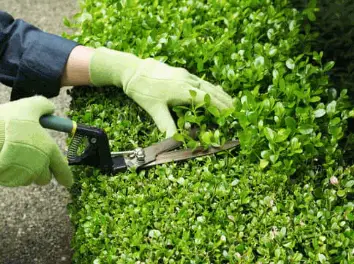
Step-by-Step Guide On How To Top Hedges
Topping a hedge is a delicate process that requires careful attention to detail. The following steps will guide you through the process:
Pruning The Sides First
Before topping your hedge, it’s essential to trim the sides first.
This prevents damaging the branches and ensures that your hedge retains its shape. Use pruning shears or a hedge trimmer to cut off any unwanted branches.
Cutting The Top
Once you’ve pruned the sides, it’s time to start cutting the top of your hedge. Using a pair of sharp pruning shears or a trimmer, cut along the top of your hedge in straight lines or curved patterns, depending on how you want it shaped.
Shaping The Hedge
After cutting along the top of your hedge, create smooth curves or angles by snipping away any extra foliage. Use sharp tools and take time with this step as it determines how neat and fresh-looking your hedgerow will appear. For more information check out our post “How To Use A Hedge Trimmer For Shaping“.
Cleaning Up Debris
Finally, clean up any debris left behind after trimming your hedgerows. This includes collecting loose leaves and twigs around your yard and disposing of them at designated areas.
Tips For A Perfect Hedge Top
While topping hedges is not an overly complicated process, these tips help you cut your hedge correctly:
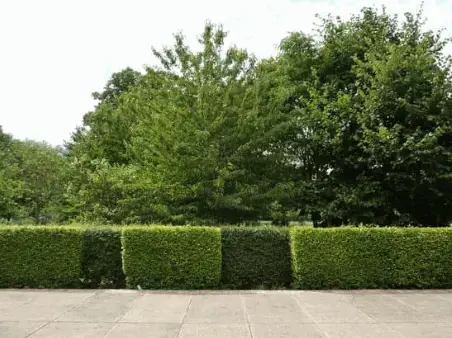
Use Sharp Tools
Dull tools can damage foliage and make cutting more tedious than necessary. Always use sharp tools like pruning shears or trimmers to get clean cuts with minimal effort, and keep your tools sharp with proper maintenance. Don’t also miss our article on how to sharpen a hedge trimmer – it offer valuable insights into this important topic.
Cut At An Angle
Cut at an angle when you start trimming hedges because this helps rainwater fall off and prevent damage to the hedge. Additionally, ensure that you cut above the leaves, not through them, to avoid affecting their photosynthesis.
Don’t Cut Too Much At Once When You Trim Hedges
You mustn’t cut off more than one-third of the entire hedge in one session. Over-pruning can cause stress to your hedge, making it vulnerable to diseases and pests.
Take trimming slowly and steadily so your hedgerows can remain healthy and robust for years. Also, be mindful of crossing branches when hedge cutting, as these branches can be problematic. By following these techniques for topping hedges carefully, you can keep your hedges looking neat and healthy all year round.
Do You Need Safety Equipment When Using Hedge Trimmers?
Safety is the golden rule, even for experienced gardeners, and this is the case when cutting hedges and thicker branches. No matter the plant species or the level of straggly growth, wearing safety equipment like goggles, long sleeves, and gloves will offer confidence when using hand shears to shape or cut hedges.
Also, take care when removing dead branches from large hedges. You should also take care to look out for nesting birds, so as to not disturb them, or place yourself at risk. For more learnings, you can check out our post “Hedge Trimmer Safety Tips“.

Types Of Hedges That Can Be Topped
There are many hedges you can work on, including informal and formal hedges, and short and tall hedges, but the following information highlights some popular forms of hedge trimming.
Boxwood Hedges
Boxwood hedges are a classic and popular choice for hedgerows. They are evergreen, which means they retain their lush green foliage all year round. Topping boxwood hedges is a great way to promote bushy, dense growth, which enhances their appearance and adds privacy to your garden or yard.
When topping boxwood hedges, it is essential to use sharp tools and cut them at an angle to prevent damaging the plant’s health. Boxwoods should be topped in the early spring or late fall before the new growth begins.
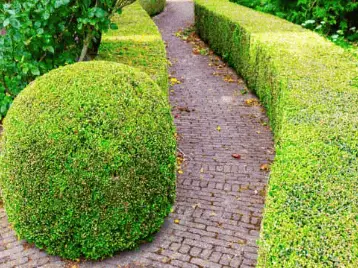
Privet Hedges
Privet hedges are another popular choice for hedgerows due to their fast-growing nature and dense leaf cover. You can top privet hedges to promote their growth and improve their aesthetics. However, unlike boxwood hedges, privets should only be topped during the early summer.
This timing allows enough time for new shoots to grow back before winter sets in again. When topping privet hedges, remove no more than one-third of the plant’s height.
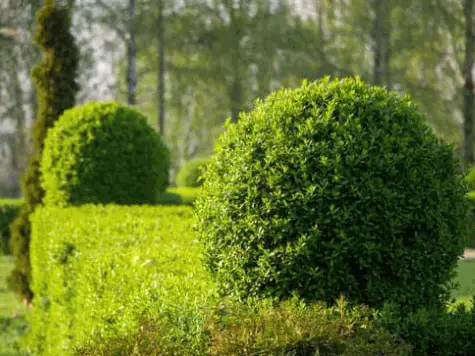
Yew Hedges
Yew is another evergreen shrub that makes an excellent hedgerow plant in gardens or yards with partial shade. Yew trees’ natural ability to grow into unique shapes when left untrimmed makes them perfect as topiary subjects and hedge plants when adequately pruned and maintained over time.
When topping yew hedges, it’s important not to prune too much off at once because this could unnecessarily damage the tree beyond repair by exposing its internal branches.
Yews should only be topped once yearly during mid-summer, with regular pruning throughout the year every 6-8 weeks for maintenance purposes. Topping your hedge can make a world of difference to its appearance and also to the overall look of your property.
However, taking care when topping hedges is important, as improper pruning can damage the plant’s health. By considering the type of hedge you have and following the right techniques for topping it, you can ensure your hedgerow stays healthy and beautiful all year round.
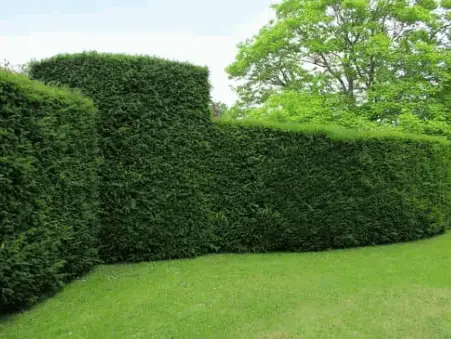
Topping Formal Hedges
Given the nature of formal and informal hedges, it stands to reason you will top formal hedges more. You can top any hedge you like, but with topping focusing on aesthetic charm and style, it makes sense that a formal hedge is more commonly topped than an informal hedge.
Maintaining A Topped Hedge
Once you have successfully topped your hedge, it is crucial to maintain it regularly to keep it healthy and looking beautiful. This section will cover the three main aspects of maintaining a topped hedge: watering and fertilising, trimming, and monitoring for pests and diseases.
Watering And Fertilising Your Hedgerows
After topping your hedge, keeping the soil around the hedge moist is essential. Watering should be done thoroughly once weekly in dry weather or when the soil feels dry. Fertilising is also vital to help your hedges grow strong and healthy after topping them.
Use a general-purpose fertiliser in early spring before the new growth starts. Follow instructions carefully to avoid over-fertilisation, which can lead to excessive growth.
Trimming Your Hedgerows Regularly
Regular trimming is required to maintain the shape of your hedgerow after topping. Do this every two months during growing seasons and consider that some hedges will grow faster than others, affecting trimming frequency.
To trim effectively:
- Use sharp pruning shears or an electric trimmer
- Cut slightly above the previous cut
- Aim for straight lines
Monitoring For Pests And Diseases
Pests like spider mites can cause significant damage to hedges if left unattended. Other common problems like diseases such as powdery mildew can also attack poorly maintained hedgerows. Insecticides are available for controlling pests (spray at early stages), while fungicides are effective against diseases, as long as you apply them at first signs.
Encourage natural predators, like ladybugs, by planting plants they are attracted to around your hedge. Regularly monitoring your hedgerow is essential to catch issues early and treat them before they become a significant problem. With hedges like a Hawthorn hedge known for sheltering birds, always undertake formative pruning with caution.
Hand Tools Help You Carry Out Maintenance At The Top Of The Hedge
Hedge topping is a vital aspect of hedge maintenance requiring the right tools, techniques, and tips to achieve a clean, neat, healthy hedge top. Following steps like pruning sides first, cutting the top, shaping the hedge and cleaning up debris properly, and adhering to tips like using sharp tools, cutting at an angle, and not cutting too much at once, you can get a perfect hedge top.
Even if you have an old hedge with tough top branches, a reliable process, dependable hand shears, and the right attitude will ensure you top and cut hedges to a high standard.
Why Hedge Trimming Is Vital For Most Homeowners
Hedge topping is crucial in ensuring privacy, security, and beauty and controlling plant size in your garden or landscape design. Trimming your hedges helps keep them neat and tidy while promoting healthy growth from the base of each shrub. Moreover, maintaining properly topped hedges helps prevent damage from pests or diseases caused by overcrowding or poor airflow.
Honing your skills on how to prune and maintain your hedgerows correctly will go a long way in keeping them healthy while presenting an impressive look for any garden design. With these techniques in mind, accompanied by good maintenance practices such as watering/fertilising regularly combined with monitoring plant health, it is easier to achieve beautifully landscaped gardens with well-maintained hedgerows year-round!
At Equipment Girl, we want you to get the most from your garden, including tall hedges, formal hedges, informal hedges, deciduous hedges, overgrown hedges and so much more. With formative pruning, you can achieve great results, and we’ll make sure you know the best hedge trimmers to trim a hedge and manage your hedges in a stylish and attractive manner/
If you want to learn more about hedge cutting and topping, we are here to assist you, so please get in touch. You can also check out our post “How To Prune, Cut & Trim Hedges A Beginners Guide” for more additional insights.

